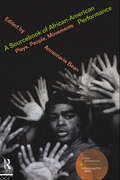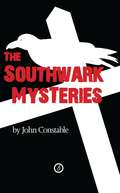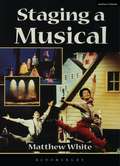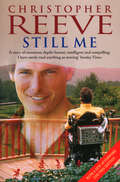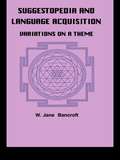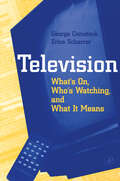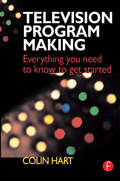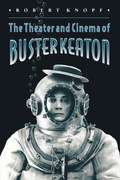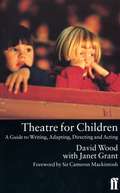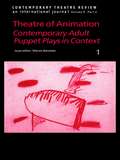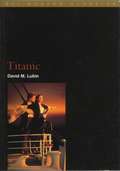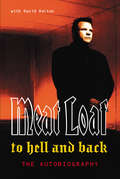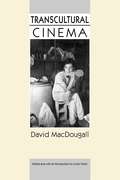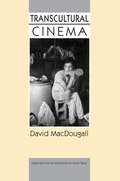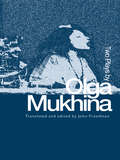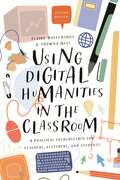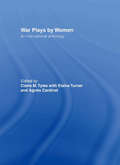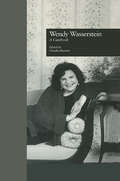- Table View
- List View
A Sourcebook on African-American Performance: Plays, People, Movements (Worlds of Performance)
by Annemarie BeanA Sourcebook on African-American Performance is the first volume to consider African-American performance between and beyond the Black Arts Movement of the 1960s and the New Black Renaissance of the 1990s.As with all titles in the Worlds of Performance series, the Sourcebook consists of classic texts as well as newly commissioned pieces by notable scholars, writers and performers. It includes the plays 'Sally's Rape' by Robbie McCauley and 'The American Play' by Suzan-Lori Parks, and comes complete with a substantial, historical introduction by Annemarie Bean.Articles, essays, manifestos and interviews included cover topics such as:* theatre on the professional, revolutionary and college stages* concert dance* community activism * step shows* performance art.Contributors include Annemarie Bean, Ed Bullins, Barbara Lewis, John O'Neal, Glenda Dickersun, James V. Hatch, Warren Budine Jr. and Eugene Nesmith.
The Southwark Mysteries
by John Constable“I was born a Goose of Southwark by the Grace of Mary Overie, Whose Bishop gives me licence to sin within The Liberty. In Bankside stews and taverns you can hear me honk right daintily, As I unlock the hidden door, unveil the Secret History.” The Liberty of the Clink dates back to 1107 when the Bishop of Winchester was granted a stretch of the Southwark Bankside, which lay outside the law of the City of London. Here, the Bishop controlled the brothels, or stews. The whores of The Liberty were known as Winchester Geese. The Vision Books of The Southwark Mysteries were first revealed by The Goose to John Crow, trickster-familiar of the poet and playwright John Constable, on 23rd November 1996. In these apocalyptic verses, John Crow encounters The Goose at Crossbones, the whores’ graveyard unearthed during work on the Jubilee Line Extension. She initiates him into a secret history spanning 2,000 years – a vision of the Spirit in the flesh, the Sacred in the profane, Eternity in time. This vision informs The Mystery Plays, a contemporary “Southwark Cycle” rooted in the medieval mysteries, retelling sacred stories in the earthy language and context of our own time and place. This epic drama was first performed in Shakespeare’s Globe and Southwark Cathedral on Easter Sunday, 23rd April 2000. A new production was presented in Southwark Cathedral in 2010. The third part of the work is a Glossolalia of local history and esoteric lore to be read in conjunction with the poems and plays." "Past and present, sacred and profane jostle and collide in a glorious tumult in this anarchic drama... it’s couched in verse that is muscular, ribald, and often dazzlingly rich... It’s sprawling and unashamedly ragged in execution, but it’s irrepressibly vital: a joyous, gutsy celebration of life, love, faith and forgiveness. " - Sam Marlowe, The Times
Staging a Musical: An Essential Guide (Backstage)
by Matthew WhiteA step-by-step guide to the whole process of putting on a musical, placing a firm emphasis upon good organisation and careful planning. This book describes all the elements involved including: how to choose the right show, budgets and schedules, auditions, rehearsals and performances. There are also sections on set designs, costumes, sound, lighting and publicity.
Still Me: A Life
by Christopher ReeveThrough his leading role in the three Superman films, Christopher Reeve became so closely identified with the superhero that he wasn't just seen as the actor who played Superman, he was Superman. Which is why the tragic riding accident which left him paralysed from the neck down shocked the world. Superman was not superhuman. It is also why he is now the world's most recognisable person in a wheelchair. In true superhero style, Christopher Reeve refuses to resign himself to the life of a quadriplegic, and is actively campaigning to raise the profile of spinal-cord injury victims and research. Although he was initially told that he would only ever be able to move his head, he can now shrug his shoulders and breathe alone for increasing periods of time, and is determined that he will walk again. It is this extraordinary courage and determination that has made Christopher Reeve the internationally admired figure that he is, and it is this bravery which makes this autobiography about his paralysis and his journey to recovery such a powerful and moving story.
Suggestopedia and Language
by W. Jane BancroftFirst published in 1999. Routledge is an imprint of Taylor & Francis, an informa company.
Suggestopedia and Language
by W. Jane BancroftFirst published in 1999. Routledge is an imprint of Taylor & Francis, an informa company.
Television: What's on, Who's Watching, and What it Means
by George Comstock Erica ScharrerTelevision: What's On, Who's Watching, and What It Means presents a comprehensive examination of the role of television in one's life. The emphasis is on data collected over the past two decades pointing to an increasing and in some instances a surprising influence of the medium. Television is not only watched but its messages are attended to and well understood. There is no shame in spending hours in front of the set, in fact, people over-estimate the time they spend viewing. Television advertising no longer persuades--it sells by creating a burst of emotional liking for the commercial. The emphases of television news determine not only what voters think about but also the presidential candidate they expect to support on election day. Children and teenagers who watch a great deal of television perform poorly on standardized achievement tests, and among the reasons are the usurpation of time spent learning to read and the discouragement of book reading. Television violence frightens some children and excites others, but its foremost effect is to increase aggressive behavior that sometimes spills over into seriously harmful antisocial behavior.Incorporates social psychology, political science, sociology, child development, and the growing field of communicationsPresents tables and graphs clarifying theories and linking sets of dataPaints concise portraits of the role of television in entertainment, politics, and child-rearingContains background for dozens of lectures and articlesContains a comprehensive bibliography of more than 1000 citations, many recent
Television Program Making: Everything you need to know to get started
by Colin HartThis book is for anyone starting out or hoping to work in the ever-expanding world of television and video. Everyone involved in a TV or video production is contributing to the program making process. They all need to know and understand how it happens. Whatever you want to end up doing, whether you are part way through a course or starting from scratch, this book gives you all the essential information you will need. It takes a practical, step-by-step approach, based on the author's own 25-year experience of producing, writing and directing for broadcast television and the corporate sector on both video and film. It describes the roles people perform, the equipment they use and what it does. In simple, easy-to-read language it explains the grammar of shooting and editing and offers first-hand advice on treatments, scripts and budgets. As well as covering the technical aspects of both single and multi-camera production, it also looks at the editorial elements that create a successful program. With practical examples it demonstrates how best to turn ideas into reality, how to obtain successful interviews and how to put together programs that work. Colin Hart has his own production company making programs for corporate clients. He trained as a single and multi-camera director in local televison news and for ten years worked in BBC Current Affairs producing and directing for Nationwide and The Money Programme.
Television Program Making: Everything you need to know to get started
by Colin HartThis book is for anyone starting out or hoping to work in the ever-expanding world of television and video. Everyone involved in a TV or video production is contributing to the program making process. They all need to know and understand how it happens. Whatever you want to end up doing, whether you are part way through a course or starting from scratch, this book gives you all the essential information you will need. It takes a practical, step-by-step approach, based on the author's own 25-year experience of producing, writing and directing for broadcast television and the corporate sector on both video and film. It describes the roles people perform, the equipment they use and what it does. In simple, easy-to-read language it explains the grammar of shooting and editing and offers first-hand advice on treatments, scripts and budgets. As well as covering the technical aspects of both single and multi-camera production, it also looks at the editorial elements that create a successful program. With practical examples it demonstrates how best to turn ideas into reality, how to obtain successful interviews and how to put together programs that work. Colin Hart has his own production company making programs for corporate clients. He trained as a single and multi-camera director in local televison news and for ten years worked in BBC Current Affairs producing and directing for Nationwide and The Money Programme.
The Theater and Cinema of Buster Keaton
by Robert KnopfFamous for their stunts, gags, and images, Buster Keaton's silent films have enticed everyone from Hollywood movie fans to the surrealists, such as Dalí and Buñuel. Here Robert Knopf offers an unprecedented look at the wide-ranging appeal of Keaton's genius, considering his vaudeville roots and his ability to integrate this aesthetic into the techniques of classical Hollywood cinema in the 1920s. When young Buster was being hurled about the stage by his comically irate father in the family's vaudeville act, The Three Keatons, he was perfecting his acrobatic skills, timing, visual humor, and trademark "stone face." As Knopf demonstrates, such theatrics would serve Keaton well as a film director and star. By isolating elements of vaudeville within works that have previously been considered "classical," Knopf reevaluates Keaton's films and how they function. The book combines vivid visual descriptions and illustrations that enable us to see Keaton at work staging his memorable images and gags, such as a three-story wall collapsing on him (Steamboat Bill, Jr., 1928) and an avalanche of boulders chasing him down a mountainside (Seven Chances, 1925). Knopf explains how Keaton's stunts and gags served as fanciful departures from his films' storylines and how they nonetheless reinforced a strange sense of reality, that of a machine-like world with a mind of its own. In comparison to Chaplin and Lloyd, Keaton made more elaborate use of natural locations. The scene in The Navigator, for example, where Buster brandishes a swordfish to fend off another swordfish derives much of its power from actually being shot under water. Such "hyper-literalism" was but one element of Keaton's films that inspired the surrealists. Exploring Keaton's influence on Salvador Dalí, Luis Buñuel, Federico García Lorca, and Robert Desnos, Knopf suggests that Keaton's achievement extends beyond Hollywood into the avant-garde. The book concludes with an examination of Keaton's late-career performances in Gerald Potterton's The Railrodder and Samuel Beckett's Film, and locates his legacy in the work of Jackie Chan, Blue Man Group, and Bill Irwin.
The Theater and Cinema of Buster Keaton (PDF)
by Robert KnopfFamous for their stunts, gags, and images, Buster Keaton's silent films have enticed everyone from Hollywood movie fans to the surrealists, such as Dalí and Buñuel. Here Robert Knopf offers an unprecedented look at the wide-ranging appeal of Keaton's genius, considering his vaudeville roots and his ability to integrate this aesthetic into the techniques of classical Hollywood cinema in the 1920s. When young Buster was being hurled about the stage by his comically irate father in the family's vaudeville act, The Three Keatons, he was perfecting his acrobatic skills, timing, visual humor, and trademark "stone face." As Knopf demonstrates, such theatrics would serve Keaton well as a film director and star. By isolating elements of vaudeville within works that have previously been considered "classical," Knopf reevaluates Keaton's films and how they function. The book combines vivid visual descriptions and illustrations that enable us to see Keaton at work staging his memorable images and gags, such as a three-story wall collapsing on him (Steamboat Bill, Jr., 1928) and an avalanche of boulders chasing him down a mountainside (Seven Chances, 1925). Knopf explains how Keaton's stunts and gags served as fanciful departures from his films' storylines and how they nonetheless reinforced a strange sense of reality, that of a machine-like world with a mind of its own. In comparison to Chaplin and Lloyd, Keaton made more elaborate use of natural locations. The scene in The Navigator, for example, where Buster brandishes a swordfish to fend off another swordfish derives much of its power from actually being shot under water. Such "hyper-literalism" was but one element of Keaton's films that inspired the surrealists. Exploring Keaton's influence on Salvador Dalí, Luis Buñuel, Federico García Lorca, and Robert Desnos, Knopf suggests that Keaton's achievement extends beyond Hollywood into the avant-garde. The book concludes with an examination of Keaton's late-career performances in Gerald Potterton's The Railrodder and Samuel Beckett's Film, and locates his legacy in the work of Jackie Chan, Blue Man Group, and Bill Irwin.
Theatre for Children: A Guide To Writing, Adapting, Directing And Acting
by David Wood Janet GrantDescribed by The Times as 'the national children's dramatist', David Wood has been writing, adapting, directing and acting in plays for children for more than twenty-five years. His best known work, from his play The Gingerbread Man to his adaptations of Roald Dahl's The BFG and The Witches have enjoyed national and international professional success and entered the repertory of amateur companies and school dramatic societies. Now David has written the definitive book on theatre for children. He analyses the skills involved in entertaining audiences of children everywhere and reveals his special techniques for catching and holding a child's attention. This practical, step-by-step comprehensive guide is essential reading for professionals and amateurs alike, and anyone wanting to be involved in theatre for children.
Theatre of Animation
by Marion BaraitserPublished in 1999, 'Theatre of Animation' is a valuable addition to the field of performance.
Theatre of Animation
by Marion BaraitserPublished in 1999, 'Theatre of Animation' is a valuable addition to the field of performance.
Titanic (BFI Film Classics)
by David M. LubinThis text looks at 'Titanic', the first film to earn over a billion dollars at the global box-office. This epic film reimagines one of the defining events of the 20th century through the lens of American romanticism.
To Hell And Back: An Autobiography
by David Dalton Meat LoafMeat Loaf's bizarre and spectacular life story is scarcely credible. After surviving an abusive childhood, during which he was almost murdered by his alcoholic father, he starred in one of the biggest stage and film musicals ever, then went on to record the third best-selling album of all time.To Hell and Back is the true story of a man who ran away from a cruel home life at 17 and starred in the legendary Rocky Horror Picture Show before turning to rock 'n' roll. His first album, Bat Out Of Hell, was considered so uncommercial by his first record label that they dropped him - only for it to go on to sell 20 million copies worldwide. He then spent the 1980s on the skids, with a severe drink and drugs problem and mounting money problems leading him to a nervous breakdown, before making a triumphant comeback with 1993's album Bat Out Of Hell II and colossal hit single 'I'd Do Anything For Love'.This is an extraordinary story and a classic rock autobiography.
Transcultural Cinema
by David Macdougall Lucien TaylorDavid MacDougall is a pivotal figure in the development of ethnographic cinema and visual anthropology. As a filmmaker, he has directed in Africa, Australia, India, and Europe. His prize-winning films (many made jointly with his wife, Judith MacDougall) include The Wedding Camels, Lorang's Way, To Live with Herds, A Wife among Wives, Takeover, PhotoWallahs, and Tempus de Baristas. As a theorist, he articulates central issues in the relation of film to anthropology, and is one of the few documentary filmmakers who writes extensively on these concerns. The essays collected here address, for instance, the difference between films and written texts and between the position of the filmmaker and that of the anthropological writer.In fact, these works provide an overview of the history of visual anthropology, as well as commentaries on specific subjects, such as point-of-view and subjectivity, reflexivity, the use of subtitles, and the role of the cinema subject. Refreshingly free of jargon, each piece belongs very much to the tradition of the essay in its personal engagement with exploring difficult issues. The author ultimately disputes the view that ethnographic filmmaking is merely a visual form of anthropology, maintaining instead that it is a radical anthropological practice, which challenges many of the basic assumptions of the discipline of anthropology itself. Although influential among filmmakers and critics, some of these essays were published in small journals and have been until now difficult to find. The three longest pieces, including the title essay, are new.
Transcultural Cinema
by David MacDougallDavid MacDougall is a pivotal figure in the development of ethnographic cinema and visual anthropology. As a filmmaker, he has directed in Africa, Australia, India, and Europe. His prize-winning films (many made jointly with his wife, Judith MacDougall) include The Wedding Camels, Lorang's Way, To Live with Herds, A Wife among Wives, Takeover, PhotoWallahs, and Tempus de Baristas. As a theorist, he articulates central issues in the relation of film to anthropology, and is one of the few documentary filmmakers who writes extensively on these concerns. The essays collected here address, for instance, the difference between films and written texts and between the position of the filmmaker and that of the anthropological writer.In fact, these works provide an overview of the history of visual anthropology, as well as commentaries on specific subjects, such as point-of-view and subjectivity, reflexivity, the use of subtitles, and the role of the cinema subject. Refreshingly free of jargon, each piece belongs very much to the tradition of the essay in its personal engagement with exploring difficult issues. The author ultimately disputes the view that ethnographic filmmaking is merely a visual form of anthropology, maintaining instead that it is a radical anthropological practice, which challenges many of the basic assumptions of the discipline of anthropology itself. Although influential among filmmakers and critics, some of these essays were published in small journals and have been until now difficult to find. The three longest pieces, including the title essay, are new.
Transcultural Cinema
by David MacDougallDavid MacDougall is a pivotal figure in the development of ethnographic cinema and visual anthropology. As a filmmaker, he has directed in Africa, Australia, India, and Europe. His prize-winning films (many made jointly with his wife, Judith MacDougall) include The Wedding Camels, Lorang's Way, To Live with Herds, A Wife among Wives, Takeover, PhotoWallahs, and Tempus de Baristas. As a theorist, he articulates central issues in the relation of film to anthropology, and is one of the few documentary filmmakers who writes extensively on these concerns. The essays collected here address, for instance, the difference between films and written texts and between the position of the filmmaker and that of the anthropological writer.In fact, these works provide an overview of the history of visual anthropology, as well as commentaries on specific subjects, such as point-of-view and subjectivity, reflexivity, the use of subtitles, and the role of the cinema subject. Refreshingly free of jargon, each piece belongs very much to the tradition of the essay in its personal engagement with exploring difficult issues. The author ultimately disputes the view that ethnographic filmmaking is merely a visual form of anthropology, maintaining instead that it is a radical anthropological practice, which challenges many of the basic assumptions of the discipline of anthropology itself. Although influential among filmmakers and critics, some of these essays were published in small journals and have been until now difficult to find. The three longest pieces, including the title essay, are new.
Two Plays by Olga Mukhina
by John FreedmanOlga Mukhina is one of the most talented, young playwrights in Russia. Born in Moscow in 1970, she has already garnered enviable praise from critics and audiences throughout Russia and Europe since her first play, Tanya-Tanya, was performed in 1996. Tanya-Tanya is an atmospheric, poetic tale that observes three couples at a suburban Moscow home who dance, drink champagne, kiss, fall in and out of love, and struggle with dignity and humor to keep some semblance of control over their lives. The parallels with Chekhovian drama are undeniable and clearly intended by the author. You, Mukhina's most recent work, is a love poem to her hometown of Moscow as well as a scathing attack on the apathy of people blindly wrapped up in their own happiness and sorrow.
Two Plays by Olga Mukhina (Russian Theatre Archive Ser. #Vol. 18)
by John FreedmanOlga Mukhina is one of the most talented, young playwrights in Russia. Born in Moscow in 1970, she has already garnered enviable praise from critics and audiences throughout Russia and Europe since her first play, Tanya-Tanya, was performed in 1996. Tanya-Tanya is an atmospheric, poetic tale that observes three couples at a suburban Moscow home who dance, drink champagne, kiss, fall in and out of love, and struggle with dignity and humor to keep some semblance of control over their lives. The parallels with Chekhovian drama are undeniable and clearly intended by the author. You, Mukhina's most recent work, is a love poem to her hometown of Moscow as well as a scathing attack on the apathy of people blindly wrapped up in their own happiness and sorrow.
Using Digital Humanities in the Classroom: A Practical Introduction for Teachers, Lecturers, and Students
by Claire Battershill Shawna RossRooted in the day-to-day experience of teaching and written for those without specialist technical knowledge, this is a new edition of the go-to guide to using digital tools and resources in the humanities classroom. In response to the rapidly changing nature of the field, this new edition has been updated throughout and now features:- A brand-new Preface accounting for new developments in the broader field of DH pedagogy- New chapters on 'Collaborating' and on 'Teaching in a Digital Classroom' - New sections on collaborating with other teachers; teaching students with learning differences; explaining the benefits of digital pedagogy to your students; and advising graduate students about the technologies they need to master- New 'advanced activities' and 'advanced assignment' sections (including bots, vlogging, crowd-sourcing, digital storytelling, web scraping, critical making, automatic text generation, and digital media art)- Expanded chapter bibliographies and over two dozen tables offering practical advice on choosing software programsAccompanied by a streamlined companion website, which has been entirely redesigned to answer commonly asked questions quickly and clearly, this is essential reading for anyone looking to incorporate digital tools and resources into their daily teaching.
War Plays by Women: An International Anthology
by Agnes Cardinal Elaine Turner Claire M. TyleeThis anthology consists of ten plays from countries involved in the First World War, including plays from Germany and France never before available in translation. Representing a range of dramatic forms, from radio play to street-epic, from comic sketch to musical, this anthology includes plays from: Gertrude Stein, Muriel Box, Marion Wentworth Craig, Dorothy Hewett, Berta Lask, Marie Leneru, Wendy Lill, Alice Dunbar Nelson, and Christina Reid. Highly successful in their day, these plays demonstrate how women have attempted to use theatre to achieve social change. The collection explores the historical development of theatrical conventions and genres and the historical context of social and gender issues.
War Plays by Women: An International Anthology
by Agnes Cardinal Elaine Turner Claire M. TyleeThis anthology consists of ten plays from countries involved in the First World War, including plays from Germany and France never before available in translation. Representing a range of dramatic forms, from radio play to street-epic, from comic sketch to musical, this anthology includes plays from: Gertrude Stein, Muriel Box, Marion Wentworth Craig, Dorothy Hewett, Berta Lask, Marie Leneru, Wendy Lill, Alice Dunbar Nelson, and Christina Reid. Highly successful in their day, these plays demonstrate how women have attempted to use theatre to achieve social change. The collection explores the historical development of theatrical conventions and genres and the historical context of social and gender issues.
Wendy Wasserstein: A Casebook (Casebooks on Modern Dramatists)
by Claudia BarnettWendy Wasserstein: A Casebook contains in-depth discussions of the playwright's major works, including her recent play 1 An American Daughter. Wasserstein's plays and essays are explored within diverse traditions, including Jewish storytelling, women's writing, and classical comedy. Critical perspectives include feminist, Bakhtinian, and actor/director. Comparisons with other playwrights, such as Rachel Crothers, Caryl Churchill, and Anton Chekhov, provide context and understanding. An interview with the playwright and an annotated bibliography are included.
